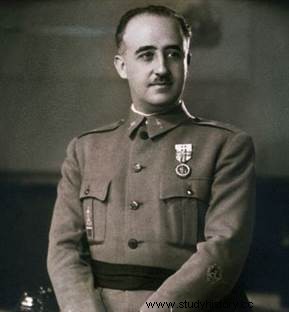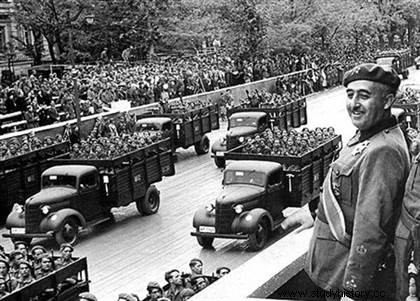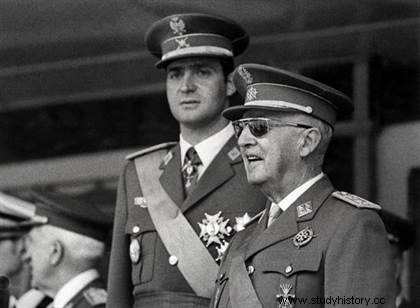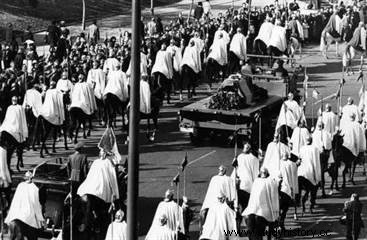 Francisco Franco (1892-1975) was a Spanish general and statesman. At the head of a military junta, in 1936 he engaged in a war against the Republican government, the Spanish Civil War , which claimed hundreds of thousands of lives. After the Nationalists' victory in 1939, Franco assumed the title of Caudillo ("the guide") and ruled Spain with an iron fist until his death in 1975. From the following year, the Francoist regime he had established - authoritarian, conservative and Catholic - gave way to a parliamentary monarchy.
Francisco Franco (1892-1975) was a Spanish general and statesman. At the head of a military junta, in 1936 he engaged in a war against the Republican government, the Spanish Civil War , which claimed hundreds of thousands of lives. After the Nationalists' victory in 1939, Franco assumed the title of Caudillo ("the guide") and ruled Spain with an iron fist until his death in 1975. From the following year, the Francoist regime he had established - authoritarian, conservative and Catholic - gave way to a parliamentary monarchy.
Franco's military career
Francisco Franco was born on December 4, 1892 into a family of ferrol sailors. Trained at the military school in Toledo (1907-1910), he served from 1912 to 1927 in Morocco and was responsible in 1920 for organizing the Spanish Foreign Legion. His brilliant conduct during the Rif War, in particular during the landing in Alhucemas Bay (September 1925), earned him the appointment of general at the age of thirty-three. Commander of the military school in Zaragoza (1927-31), he was expelled by the Republican regime and appointed to the Balearic Islands (1933). Called back to the metropolis after the electoral victory of the Conservatives, in 1934 he took part in the repression of the uprising in Asturias.
 In 1935 he was appointed by Alcalá Zamora Chief of General Staff of the Army. In 1936, after the victory of the Popular Front, he was removed again and appointed head of the general command of the Canary Islands. With Godet and Queipo de Llano, he then entered into a plot led by General Sanjurjo. When the nationalist uprising broke out on July 17-18, 1936, he flew to Spanish Morocco, took control of it, and took command of the insurgent forces in southern Spain.
In 1935 he was appointed by Alcalá Zamora Chief of General Staff of the Army. In 1936, after the victory of the Popular Front, he was removed again and appointed head of the general command of the Canary Islands. With Godet and Queipo de Llano, he then entered into a plot led by General Sanjurjo. When the nationalist uprising broke out on July 17-18, 1936, he flew to Spanish Morocco, took control of it, and took command of the insurgent forces in southern Spain.
In the Spanish Civil War
Following the accidental death of Sanjurjo, he was appointed Generalissimo by the military junta of Burgos (September 12), then Head of State (September 29, 1936) . In this position, while personally directing the military operations which resulted in the defeat of the Republicans in March 1939, the "caudillo" laid the foundations of the new state by establishing a single party (April 1937) and a state organization of labor .
Supported by the Spanish right, including the phalanxes of Primo de Rivera, he began a victorious march, sowing terror as far as Madrid, with the famous battle cry "Viva the dead! ". He benefited from the military assistance of Fascist Italy and Hitler's Germany, and even before the end of the civil war obtained diplomatic recognition from France and Great Britain, soon followed by that of the United States.
In 1939, combining the function of head of government, he found himself the undisputed master of Spain, which he undertook to rebuild on the basis not of fascism, but of an authoritarian, catholic and corporatist state. Despite the help he had received from the German-Italians and his adherence to the Anti-Commintem pact (March 1939), Franco proclaimed his neutrality at the start of the Second World War, then, after the defeat of France, he passed to "non-belligerence", occupied Tangier (June 1940) and claimed Gibraltar. However, he resisted pressure from Hitler during the interview at Hendaye (Oct. 23, 1940). In 1941, he agreed to send workers to Germany and a Spanish contingent, the Azul Division, to the U.S.S.R., where it fought alongside the Germans.
From 1942, with the prospect of an Allied victory, he began a slow liberalization of his regime (establishment of Cortes, July 1942; replacement of Serrano Sufter by Jordana at the Foreign Affairs, Sept 1942), returned to neutrality (Oct 1943) and withdrew the Azul Division from the Eastern Front.
The Franco regime
Very isolated however after the collapse of the fascist powers, condemned by the U.N. (February 1946), he knew how to mobilize in his favor the Spanish national pride. The development of the Cold War allowed him to benefit from the Marshall Plan (March 1948) and made him a valuable auxiliary for the Americans (economic-military agreements of September 1953). In 1955, he was able to get Spain admitted to the UN. Although the Succession Law of 1947 defined Spain as a kingdom and Prince Juan Carlos was officially designated as the future King of Spain, the "caudillo" retained power as a kind of regency for life. P>
 While Spain entered a phase of economic boom from 1955, Franco presided over the gradual replacement of the old guard from the civil war by a new ministerial staff of technocrats, often close to Opus Dei. However, Franco maintained until the end the fundamental bases of the regime which he had established since the time of the civil war, and his last months in power were marked by fierce repression against revolutionary intrigues and against Basque autonomy, repression accentuated by the assassination by ETA of its second Luis Carrero Blanco in December 1973.
While Spain entered a phase of economic boom from 1955, Franco presided over the gradual replacement of the old guard from the civil war by a new ministerial staff of technocrats, often close to Opus Dei. However, Franco maintained until the end the fundamental bases of the regime which he had established since the time of the civil war, and his last months in power were marked by fierce repression against revolutionary intrigues and against Basque autonomy, repression accentuated by the assassination by ETA of its second Luis Carrero Blanco in December 1973.
Franco's impossible legacy
De Franco therefore remains an ambivalent image. There is first of all that of the shrewd tactician on the international level, who succeeds, while maintaining an authoritarian power and in defiance of the elementary rules of democracy, to reintegrate the concert of nations. On the other hand, there is the image of a man without qualms, basing his power on political repression and the muzzling of all forms of freedom of expression; which, ultimately, gives little credence to those who judge that the Franco of the last few years wanted — even if he doubtless anticipated — a transition to democracy after his death.
 He died on November 20, 1975 after a long agony and will be buried with Primo de Rivera and the victims of the civil war in the valley of Los Caidos in a monument built by... thousands of political prisoners. As expected, Juan Carlos I succeeded him and began Spain's democratic transition, which culminated in the coming to power of a socialist government in 1982.
He died on November 20, 1975 after a long agony and will be buried with Primo de Rivera and the victims of the civil war in the valley of Los Caidos in a monument built by... thousands of political prisoners. As expected, Juan Carlos I succeeded him and began Spain's democratic transition, which culminated in the coming to power of a socialist government in 1982.
Forty four years after the death of General Franco, his body was exhumed on October 24, 2019 following a law passed in 2017, and his remains transferred to the cemetery of Mingorrubio . The heated debates and the legal battle that took place on this occasion proved that the wounds left by Franco and his regime are still not healed in Spain.
Bibliography
- Francisco Franco:Cross Biographies, by Paul Preston and Angel Palomino. Grancher, 2005.
- Franco, biography of Bartholome Bennassar. Tempus, 2002.
- History of Franco's Spain, by Max Gallo. Laffont, 1975.
